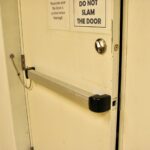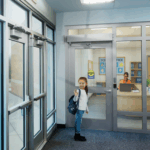This post will be published in the January 2019 issue of Door Security + Safety
 One of the most common questions I receive is whether automatic operators are mandated by the model codes or by the accessibility standards. Currently, automatic doors are not required by the national codes or standards used in the US, although automatic doors can be an alternative when doors do not meet the accessibility requirements for manual doors. There have been several states and local jurisdictions that require automatic doors in certain situations, and now there is a model-code change proposal in progress that is worth keeping an eye on.
One of the most common questions I receive is whether automatic operators are mandated by the model codes or by the accessibility standards. Currently, automatic doors are not required by the national codes or standards used in the US, although automatic doors can be an alternative when doors do not meet the accessibility requirements for manual doors. There have been several states and local jurisdictions that require automatic doors in certain situations, and now there is a model-code change proposal in progress that is worth keeping an eye on.
The code development cycle for the 2021 International Building Code (IBC) is well under way. Proposal E115, submitted by a representative of the American Association of Automatic Door Manufacturers, calls for some public entrances to have automatic doors. To understand the scope of the proposal, we first need to define which doors are public entrances that are required to be accessible. Currently, the IBC requires at least 60 percent of all public entrances to be accessible, in addition to the following:
- Parking Structures: Where direct pedestrian access is provided from a parking garage to a building or facility, the entrances must be accessible.
- Tunnels and Elevated Walkways: Where direct pedestrian access is provided from a pedestrian tunnel or elevated walkway to a building or facility, at least one entrance from each tunnel or walkway must be accessible.
- Restricted Entrances: Where restricted entrances are provided to a building or facility, at least one restricted entrance must be accessible.
- Entrances for Inmates or Detainees: At judicial facilities, detention facilities, and correctional facilities, where entrances are used only by inmates or detainees and security personnel, at least one such entrances must be accessible.
- Service Entrances: When a service entrance is the only entrance to a building or tenant space, that entrance must be accessible. When a service entrance is not the only entrance to a tenant space, the service entrance is not required to be accessible.
- Tenant Spaces: At least one accessible entrance must be provided to each tenant space, except for self-storage facilities that are not required to be accessible.
- Dwelling Units and Sleeping Units: Each dwelling unit and sleeping unit in a facility must have at least one accessible entrance, except that an accessible entrance is not required for units that are not required to be Accessible units, Type A units, or Type B units.
Note: If an area is not required to be accessible, an accessible entrance is typically not required. This means that areas that are exempt from the accessibility requirements are usually also exempt from the requirements for an accessible entrance. Refer to the applicable building code or accessibility standard to learn more about these exceptions.
IBC proposal E115 would require at least one accessible exterior public entrance to have an automatic operator, for buildings in specified use groups with occupant loads over a certain threshold. If the current proposal is approved, the requirement would apply to assembly occupancies (Group A-1, A-2, A-3, and A-4) with an occupant load greater than 300 people. It would also apply to business, mercantile, and Group R-1 residential occupancies with an occupant load greater than 500 people (Group R-1 facilities are typically hotels, motels, boarding houses and other transient living facilities with more than 10 occupants). The proposal requires the automatic operators at these entrances to be full-power-operated doors or low-energy automatic doors. Power-assist operators that reduce the opening force but still require manual operation would not meet the requirements.
Although the proposal was approved by the technical committee, there were 3 public comments submitted which could modify the proposal. The public comments could increase the number of doors which require automatic operators – none of the public comments proposed disapproval of the proposal, although there’s a slight chance that the proposal could be disapproved. It’s too soon to know for sure what the final outcome and exact code language will be, but this will be clarified as the code development cycle continues.
 One of the issues addressed by public comment is related to a change made in the 2017 edition of ICC A117.1 – Accessible and Usable Buildings and Facilities. Although this edition of the standard is not yet referenced by the model codes, it requires public entrances with automatic operators to have full-powered automatic doors or low-energy automatic doors. This edition of the standard also requires the corresponding vestibule door(s) to have the same type of operator as the exterior door. The A117.1 requirement for public entrances is intended to establish that when an automatic operator is required because of a project specification, owner preference, code or other mandate, an automatic operator (full-powered or low-energy) must be used rather than a power-assist operator.
One of the issues addressed by public comment is related to a change made in the 2017 edition of ICC A117.1 – Accessible and Usable Buildings and Facilities. Although this edition of the standard is not yet referenced by the model codes, it requires public entrances with automatic operators to have full-powered automatic doors or low-energy automatic doors. This edition of the standard also requires the corresponding vestibule door(s) to have the same type of operator as the exterior door. The A117.1 requirement for public entrances is intended to establish that when an automatic operator is required because of a project specification, owner preference, code or other mandate, an automatic operator (full-powered or low-energy) must be used rather than a power-assist operator.
While these changes have not yet been officially added to the model codes, I think it’s safe to say that the requirements for automatic operators will increase in the coming years. If the 2021 IBC requires automatic operators for some public entrances, this would become enforceable when a jurisdiction adopts that edition of the code. It’s likely that the requirement would only apply to new buildings and renovations, and that existing buildings would not have to be modified. However, given the preference toward automating doors at public entrances, facility managers and architects may want to consider providing this accessibility improvement sooner rather than later.
You need to login or register to bookmark/favorite this content.







Am I the only one who finds it a little suspect that the American Association of Automatic Door Manufacturers is asking for operators in places where ANSI-117.1 doesn’t? Granted, I’m all for selling more hardware but operators and their accessories really add to the cost of a project.
Hi Eric –
It’s actually very common for organizations like this to submit code change proposals. BHMA submits quite a few proposals for the IBC and for NFPA 101, along with other codes and standards. I think it’s appropriate, as we know our business and can help to clarify the code requirements. The revision to A117.1-2017 seems to indicate a preference for automatic doors on public entrances.
– Lori
Eric Riecker, I was thinking the same thing. Let’s write a code that is sure to increase my sales.
You discuss automating Entry doors.
Would these requirements carry over to exit doors as well? And thus need backup power (batteries, standby generators) ? After all, if a person needs assistance to enter, it’s likely they would have needs to escape as well.
Hi Joel –
If an automatic operator is used on a door that does not have the proper maneuvering clearance for a manual door on the egress side, the 2010 ADA and the 2017 A117.1 require standby power for those doors. It’s a different issue from the one that I addressed in the current article, but there’s more info about it here: https://idighardware.com/2011/08/auto-operators-stand-by-power/.
– Lori
Eric, if that proposal seems a bit self serving to you I would strongly suggest you never look into the long, long history of proposals the American Fire Sprinkler Association has submitted for a variety of NFPA standards over the last several decades much less how many of those same NFPA standards have an American Fire Sprinkler Association representative sitting on the very technical committee who will vote on the proposal. These same technical committee representatives are neither expected nor required to abstain from voting on such proposals in which they clearly have a vested interest. And this is but just one example of trade associations who constantly attempt to influencing code writing / standard setting organizations. Sadly the ANSI method of code writing/development does allow for a manufacturer of a device or their trade association to try to get a code to simply mandate their product instead of the manufacturer needing to create a demand for the product in the marketplace. In comparison, the European DIN standards are developed and written using a science-based process as opposed to ANSI which is essentially a political based process.
Automatic door operators are definitely beneficial for a wide range of people. If additional automatic door operators are required for public entrances, I believe it’s beneficial and creates greater accessibility. It relieves the burden of people having to deal with heavy doors and negatively pressurized buildings that create a vacuum effect at entrances. In light of our increasingly aging in place population, this potential modification to the code is a positive step forward to creating truly accessible buildings.
where can I find out if this passed and automatic door openers are now required?
Hi Lori –
I had not written an updated post that included the new code section, so I wrote it today: https://idighardware.com/2021/04/code-update-automatic-operators-on-public-entrances/
– Lori
Lori, the article states that 2017 A117.1 is not yet referenced in the building codes. Where exactly do the codes call out 2009 edition? IBC refers to A117.1 but does not call out 2009 version.
This article is from a few years ago, so the 2017 edition has now been referenced in the 2021 model codes. But to answer your question, the edition is found in the chapter called “Referenced Standards.” For example, in the 2018 IBC this is Chapter 35, and if you go down to ICC (International Code Council) you will see A117.1 with “-09” indicating the 2009 edition.
– Lori